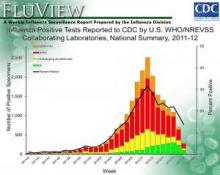The current U.S. influenza seasonal epidemic, the mildest in years, is in its death throes, based on infection trends over the past several weeks, including the most recent data released on May 11 by the Centers for Disease Control and Prevention.
During the week that ended on May 5, 13.7% of U.S. respiratory surveillance specimens tested positive for influenza, continuing the clear downhill slope of U.S, flu cases since this season’s U.S. epidemic peaked at 30% positive during the week of March 11-17. The CDC hasn’t yet declared the current, 2011-2012 flu-season’s epidemic, which started in late February, officially over—it can’t until the influenza-positive rate falls back below 10%–but the epidemic curve’s steep downward track (see graphic) is as well defined as the far side of L’Alpe d’Huez.
With the current influenza epidemic nearly ended, the season’s numbers paint a decidedly benign picture. So far, 22 children have died from influenza; if that figure continues to grow as it has so far it will top out as the lowest since the CDC began collecting these data in 2004.
Other markers of how mild the 2011-2012 season has been include the number of U.S. patients hospitalized for influenza, which sits below past seasons, and the proportion of deaths attributable to pneumonia or influenza has hovered below the epidemic threshold for that measure all season.
During a winter and spring where the influenza world focused on mammalian-transmissible H5N1 flu, strains dubbed by some the “doomsday” virus, having such a mild seasonal flu season tossed at us can’t help but be seen as some ironic, natural-world prank. On a purely rationale basis, year-to-year variations in seasonal flu have nothing whatsoever to do with the looming danger from H5N1 flu, but with this infectious-disease juxtaposition I can’t help but imagine that somewhere, off in the distance, I hear a quiet, cosmic chortle.
—Mitchel Zoler (on Twitter @mitchelzoler)


